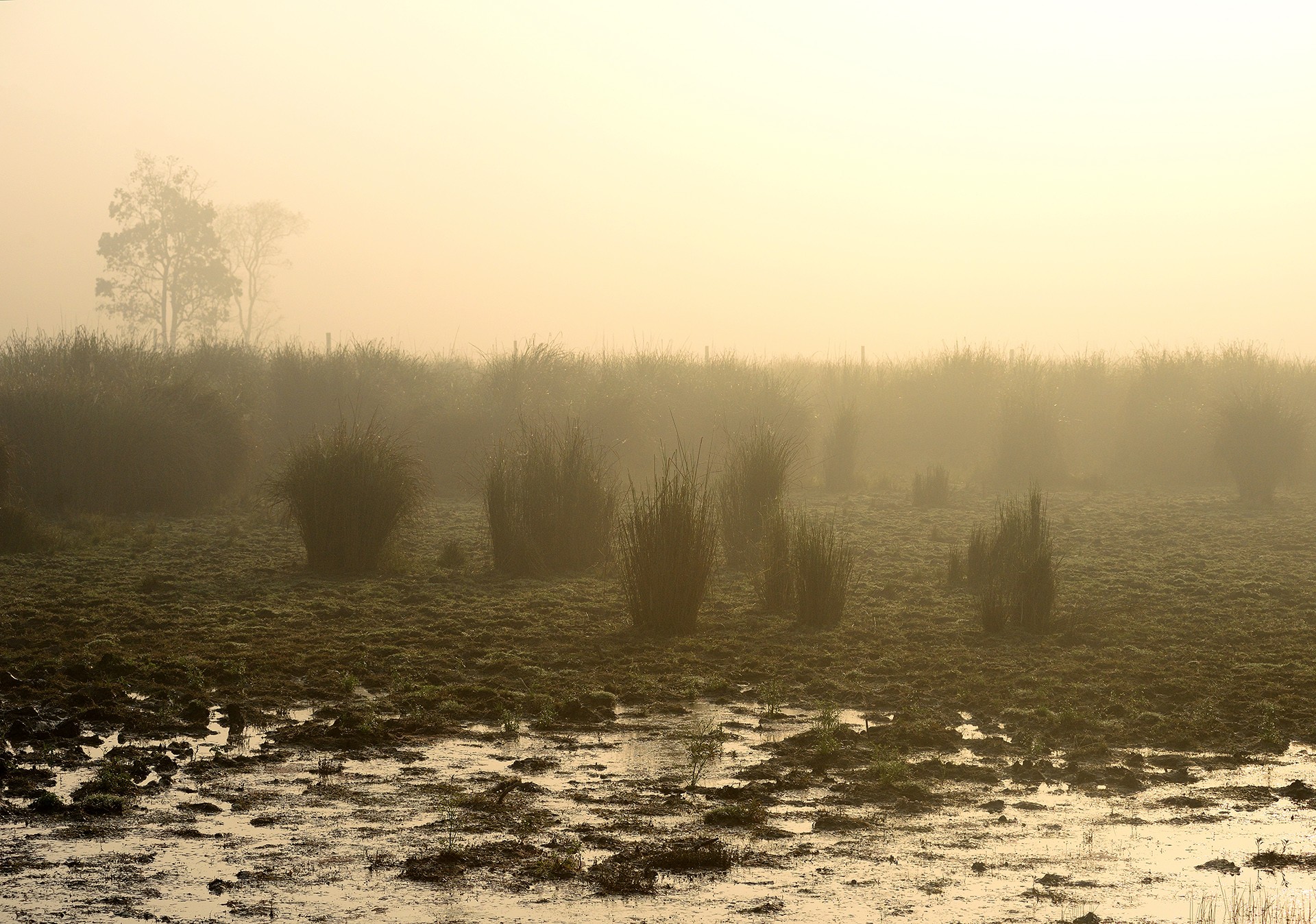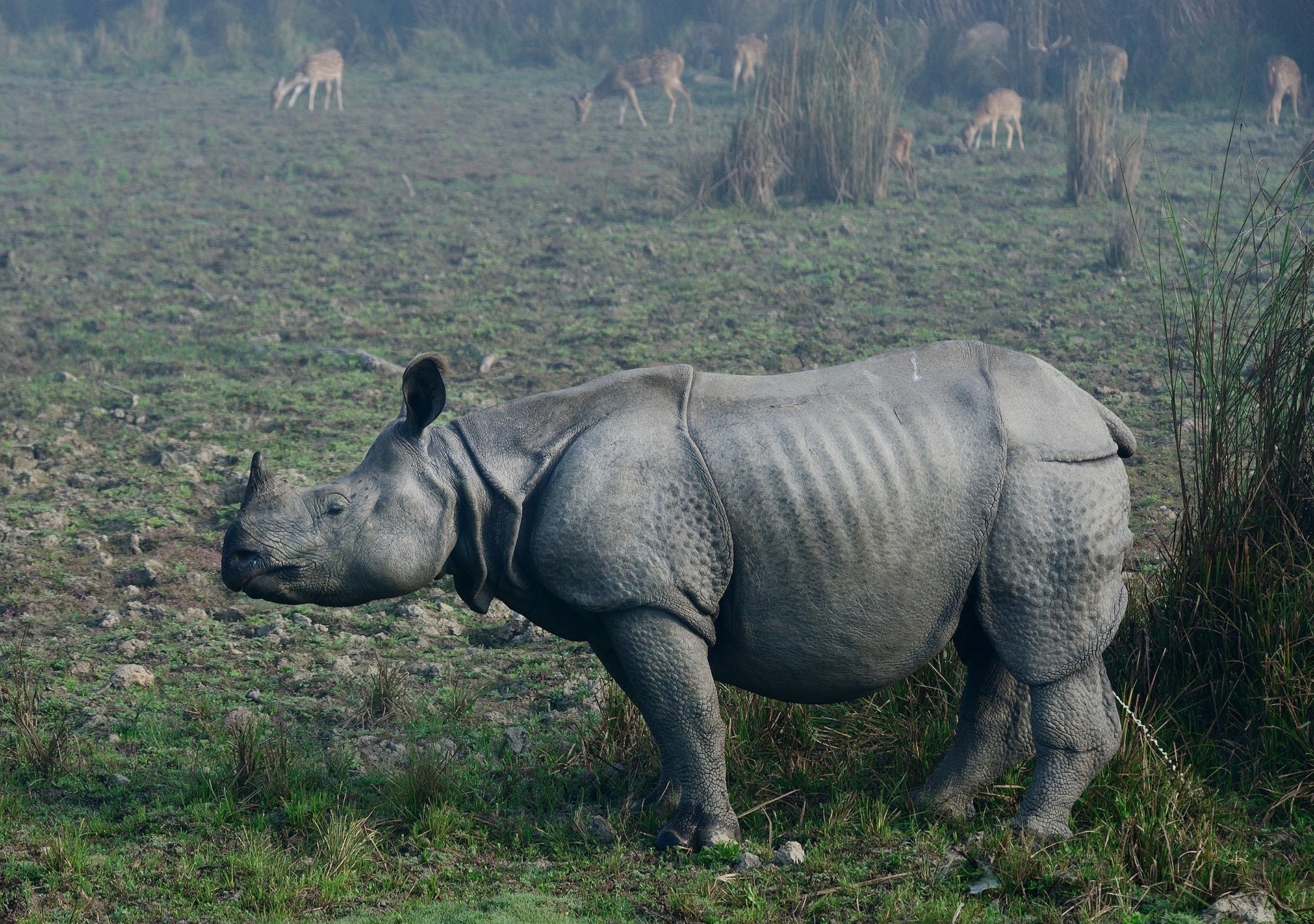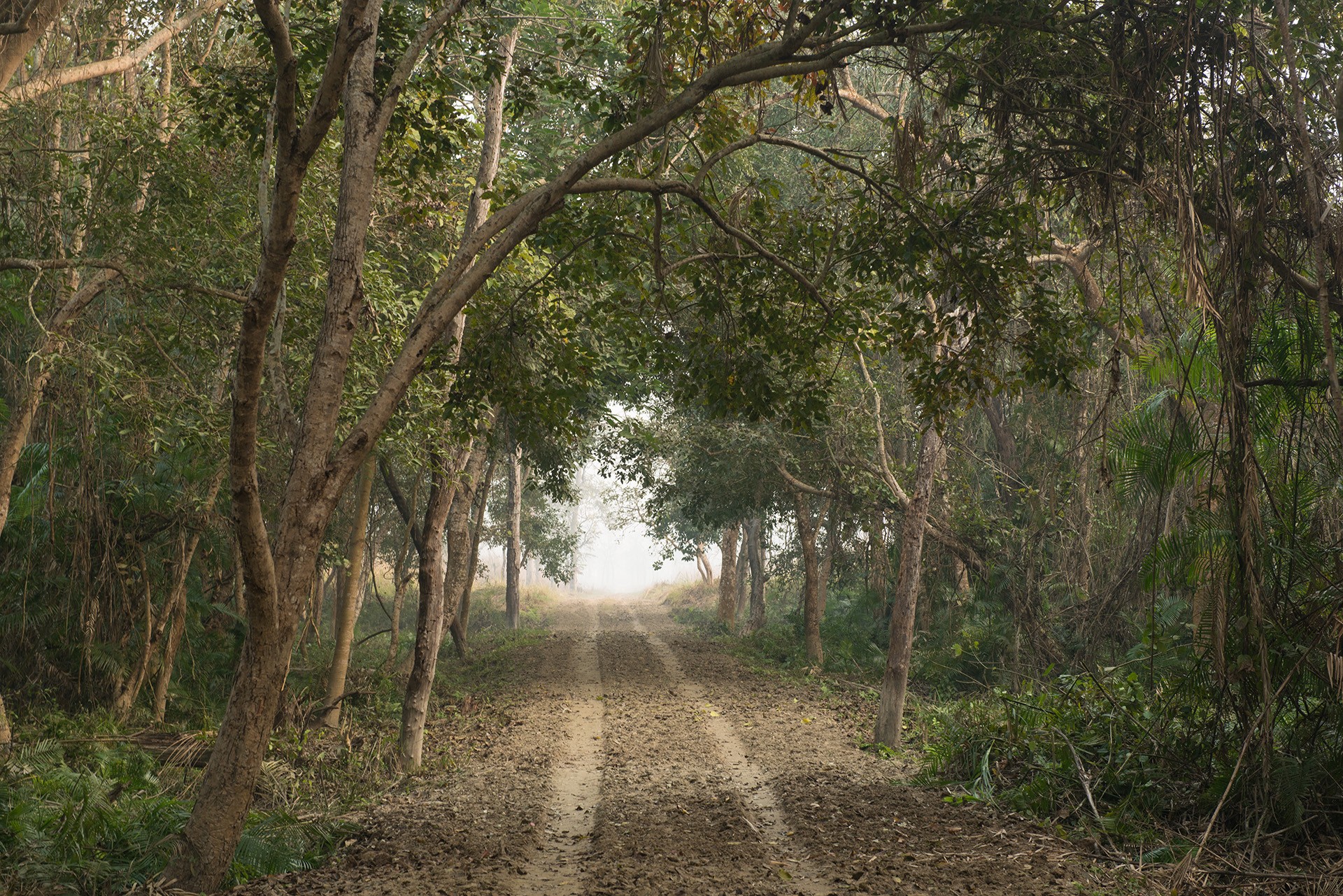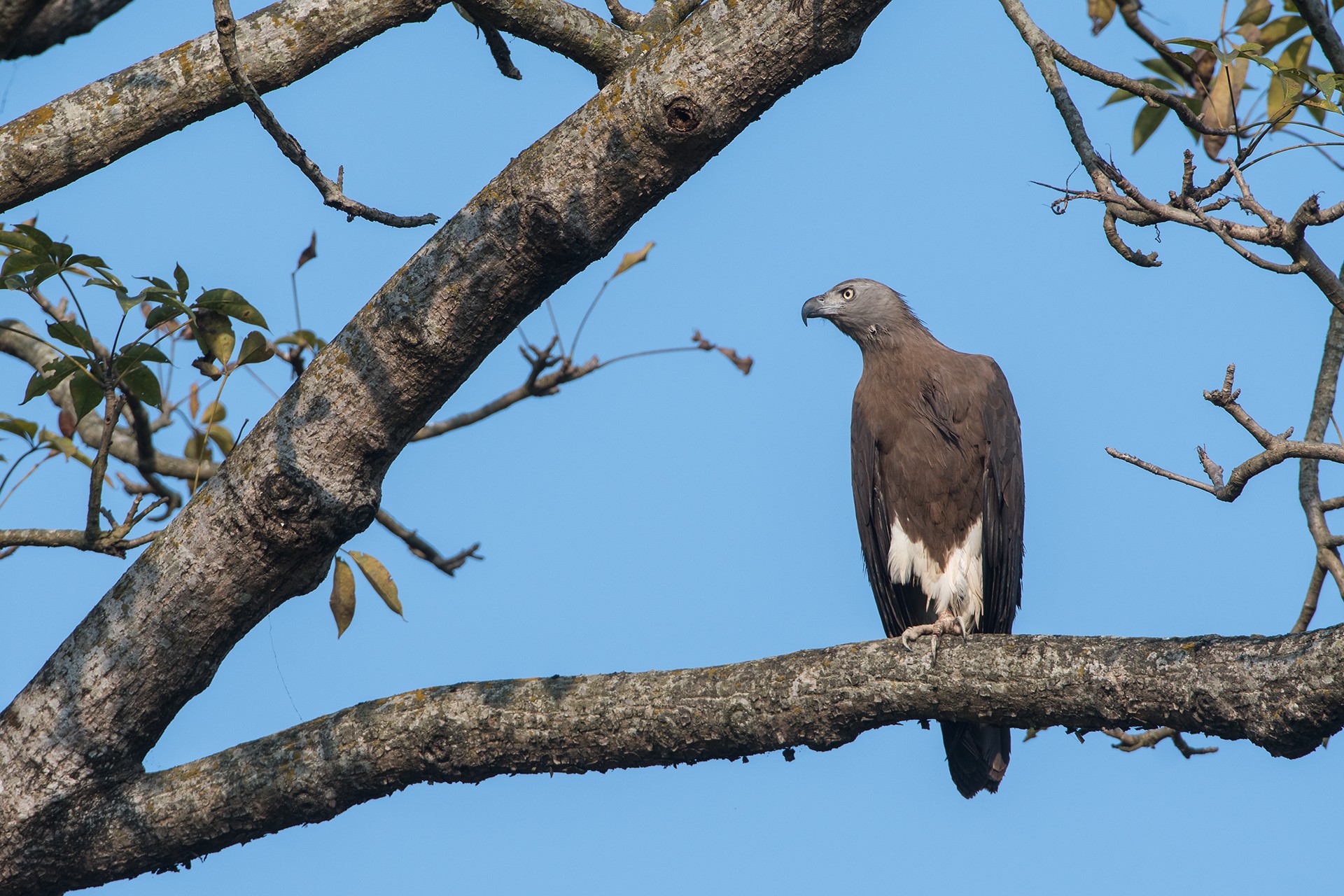The forest was uncharacteristically quiet; the alcove where our vehicle stood, even quieter. There were no alarm calls, no birdsong, no movement (none that was visible to us, that is). It was the kind of morning that made you wonder where all the wild things had gone. Mist clung to everything, like a determined, snug white cloak, enveloping the mighty sal and the high grass. Our jeep sliced through the mist as we drove, the trails seeming to appear gradually from within it, like ghosts in the darkness, trees reaching out like limbs, appealing to the parts of my imagination that host everything creepy.
In that thick silence, we became aware of another sound, a regular pat-pat-pat, like a light rain on the dense canopy of teak and sal that arched high up above us. It wasn’t rain, of course, it was October, and it seemed that winter had only just gotten the memo because it was still rather hot. No, this was the morning dew dripping urgently on to the leaves, determined to get the day started - an endeavour ably aided by the soft morning light puncturing the mist in parts, nudging the forest to life.
Dudhwa Tiger Reserve (approximately 1,230sqkm) in Uttar Pradesh hosts the Dudhwa National Park (600sqkm), Kishanpur Wildlife Sanctuary (230sqkm) and Katarniaghat Wildlife Sanctuary (400sqkm). The newly notified Pilibhit Tiger Reserve sits alongside, forming a long contiguous forest belt in Uttar Pradesh. Life exists in different ecosystems in the state - namely in regions of the Terai, the Gangetic plains, Chambal, and the Vindhyas. Dudhwa itself, home to the Swamp Deer or the Barasingha, is a vital wetland ecosystem.
If you’ve never heard of Dudhwa, it’s probably because for travellers, it’s eclipsed by Corbett National Park - its more popular, broad-shouldered neighbour in Uttarakhand. And if you have heard of it, it’s probably in reference to the man the park owes its very existence to: Billy Arjan Singh. A warrior for tiger conservation till his last breath (in 2010), Singh got Dudhwa National Park notified with the backing of the then Prime Minister, Indira Gandhi. A visit to the park is incomplete without stories of his volatile relationship with the forest authorities, the controversy around the zoo-bred tigress Tara, whom he raised and released into the wild, and the captive leopards he formed a close bond with. Singh fought valiantly for trophy hunting to be banned, and warred fearlessly with anything that posed a threat to the inhabitants of the forest; especially corruption and human interference. This earned him a fair number of enemies but he remained single-minded in his focus and his heart beat only for Dudhwa till the very end.
Apart from being Singh’s legacy, Dudhwa Tiger Reserve is one of the few places in India where you can see the one-horned rhinoceros in the wild. Once found extensively all over the Indo-Gangetic belt, excessive hunting and poaching now restricts the rhino to parts of Nepal and Assam. Again, under the reign of Indira Gandhi, the forest department successfully reintroduced rhinos in the park in 1984-85, and they survive in an enclosure that you can unfortunately visit only on elephant back given the swampy marshland of the Terai belt.
To say that the uneven forest floor, with no definitive jeep trails, is undulating, would be an understatement of massive proportions. As the elephant, a spirited fellow named Gajaraj, stomped through the marshland, we dodged piercing stray branches and ducked to avoid enormous webs of Giant Wood Spiders, all of which were now regrettably, at eye-level. Giant roots reached out from both sides and met on the sludgy path, and enormous clumps of tall grass sat close together, undoubtedly hiding a large number of living organisms baying for our blood.
On elephant back, we moved through the forest with ease. We sloshed through the marsh, navigated knee-deep water and confidently looked for tigers. On elephant back, we were untouchable. On foot, the same journey would be unthinkable. The clumps of grass were taller than I was and the sal and teak were so dense that the foliage seemed impenetrable without a trunk and skin that didn’t bruise easily. This was truly the wild heart of the forest.
Minutes had turned into hours in the swamp, with mosquitoes having sent out invitations to their friends for a feast, when we came upon a little rhino (a gorgeous three-year-old), in a small clearing. This was the first time I’d seen a rhino up close (the other being the extremely threatened White Rhino in Africa). It struck me anew how strange this animal looks - like it has been made from leftover clay from other animals: shaped like a hippo, ears like a horse, the face (and hide) of a stegosaurus, hooves like that of a goat. And then that horn! The oddest thing, however, is that it works. As we watched the calf uncertainly clocking our approach, I was elated by its weird, almost prehistoric look. I could have watched him for hours. The rhino wasn’t as at leisure, and after giving us a good ten minutes of hapless photo ops, he strolled off into the forest and out of sight.
We didn’t have quite the same luck with the Barasingha. We saw a stray pair wallowing in the water in the rhino enclosure, but we were here at the wrong time. In summer, you can probably witness the largest congregation of swamp deer from one of the watchtowers in Kishenpur National Park. At that time, even the tall grass would be burned down for new soil, so visibility is much higher. This is also the season that the Bengal Florican attempts to find its mate in an interesting courting ritual: it jumps high in the air, repeatedly and in different directions each time to attract a female. Dudhwa is also a great place to spot the Sarus Crane, one of the tallest flying birds in the world (30 per cent of India’s population is found in UP).
But more than anything, it is wild, untamed, dense, a little rogue, yet untouched by the frantic circus of today's tiger tourism. But that could be a myopic assumption, given we were lucky enough to be the sole car in the reserve. It would be interesting to see the park at full flow, with tourists waiting for a peep of the tiger. Just as well as I need to return - there is much to see; because
I came for the tiger, but did I stay for this forest! Visit for tremendous birding, crocodiles, jackals, otters, rhinos, deer, and so much more.
Choose Dudhwa. I remain smitten.
Fact file: How to get there
By Air: Lucknow (238km) is the closest airport.
By Rail: The nearest railheads are Dudhwa (4km), Palia (10km) and Mailani (37km). The most convenient way would be to reach Lucknow and then travel on to Dudhwa by road or train.
By Road: These are the distances from major cities - Lucknow: 238km; Delhi: 410km; Mumbai: 1,277km; Bengaluru: 1,697km
Best time to visit
From November to May. Summer is uncomfortably hot, but the sightings of mammals and birds (and their courting rituals) make up for it.
Note: The author travelled to Dudhwa on invitation from the Uttar Pradesh Tourism Board, as part of the Travel Writer's Conclave 2016, and got a brief glimpse into the forest, with only one trail operational before season opened for tourists.





